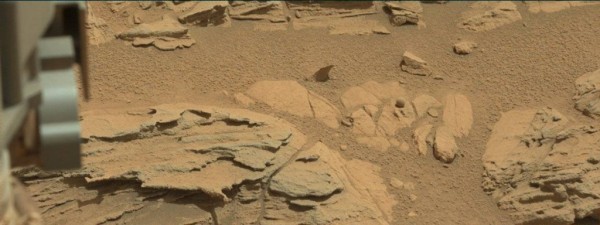NASA Explains "Golf Ball" Photo Taken by Curiosity on Mars
| Ana Verayo | | Sep 28, 2014 03:33 AM EDT |
(Photo : NASA/JPL-Caltech/MSSS ) This image was taken by the Mastcam on board NASA's Mars rover Curiosity on Sol 746 (2014-09-11 14:46:57 UTC).
NASA's Curiosity rover has arrived at its prime destination, Mount Sharp, capturing thousands of remarkable images of Martian terrain along the way. Some of these photos, however, are rather inexplicable.
Curiosity's Mars Science Laboratory Mastcam camera took a recent photos later uploaded to Curiosity's archive on sol 746 last September 11. While scanning through the landscape and documenting the terrain, however, Curiosity captured an odd shape of what appears to be a most perfect spherical ball amidst dusty, jagged rocks.
Like Us on Facebook
Some observers describe it as a golf ball or a cannonball. As expected, this mystery led to multiple theories from UFO enthusiasts that this out of place looking ball of a rock could be alien made.
Scientists from NASA's Jet Propulsion Laboratory, however, said this "ball" isn't really large in size but rather is just one centimeter wide. Scientists said this ball was formed by a phenomenon called "concretion" during the sedimentary rock formation stage when liquid water still existed on Mars millions of years ago.
This unique type of rock formation leads to evidence that Mars used to have a wetter climate. Curiosity confirmed this phenomenon while exploring an ancient lakebed located inside Gale Crater.
Earth's sedimentary rock layer also formed the same way with water transporting, displacing and depositing particles slowly. Over time, these minerals bound together to form rocks.
These concretions however formed in a stage where newly formed, soft sedimentary rock layers developed pores. Minerals and other particles filtering through these pores progressively formed a solid mass resistant to erosion and other types of weathering.
This particular ball seen by Curiosity is a classic example of this type of weathering in which the sedimentary rock it came from slowly deteriorated, leaving the ball to wobble away among the terrain over time.
Curiosity will now begin drilling on Mount Sharp. It will then analyze powdered rock samples to study how Mars supported microbial life.
TagsNASA Explains "Golf Ball" Captured by Curiosity Rover on Mars, NASA, Mars, mount sharp, Curiosity Rover, ball nasa mars curiosity rover
©2015 Chinatopix All rights reserved. Do not reproduce without permission
EDITOR'S PICKS
-

Did the Trump administration just announce plans for a trade war with ‘hostile’ China and Russia?
-

US Senate passes Taiwan travel bill slammed by China
-

As Yan Sihong’s family grieves, here are other Chinese students who went missing abroad. Some have never been found
-

Beijing blasts Western critics who ‘smear China’ with the term sharp power
-

China Envoy Seeks to Defuse Tensions With U.S. as a Trade War Brews
-

Singapore's Deputy PM Provides Bitcoin Vote of Confidence Amid China's Blanket Bans
-

China warns investors over risks in overseas virtual currency trading
-

Chinese government most trustworthy: survey
-

Kashima Antlers On Course For Back-To-Back Titles
MOST POPULAR
LATEST NEWS
Zhou Yongkang: China's Former Security Chief Sentenced to Life in Prison

China's former Chief of the Ministry of Public Security, Zhou Yongkang, has been given a life sentence after he was found guilty of abusing his office, bribery and deliberately ... Full Article
TRENDING STORY

China Pork Prices Expected to Stabilize As The Supplies Recover

Elephone P9000 Smartphone is now on Sale on Amazon India

There's a Big Chance Cliffhangers Won't Still Be Resolved When Grey's Anatomy Season 13 Returns

Supreme Court Ruled on Samsung vs Apple Dispute for Patent Infringement

Microsoft Surface Pro 5 Rumors and Release Date: What is the Latest?










